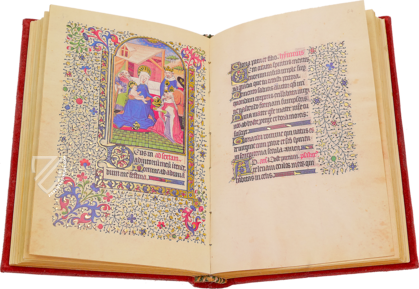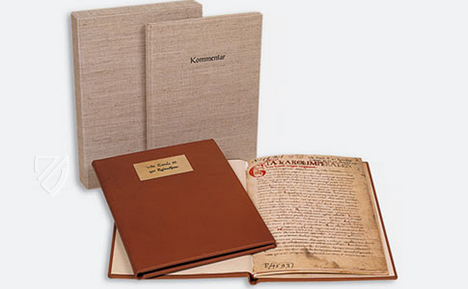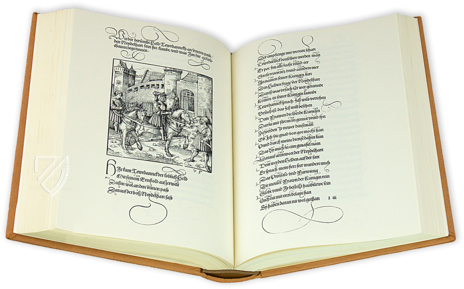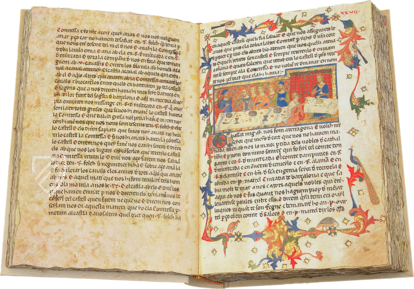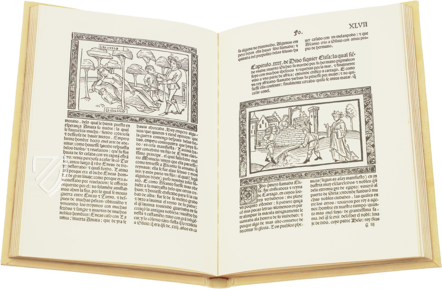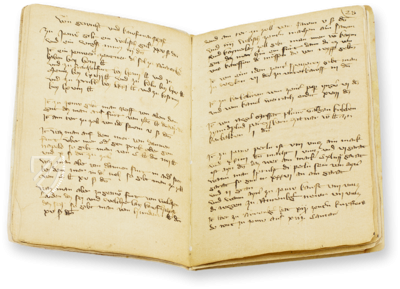The Pageants of Richard Beauchamp
(under 1,000€)
The Pageants of Richard Beauchamp, Earl of Warwick are so-called because they consist of a series of drawings representing scenes or “pageants” from the life of the English earl, military commander, and important political figure during the reigns of Henry IV, Henry V, and Henry VI during the final period of the Hundred Years' War. Likely compiled at the behest of his daughter Anne, this manuscript is the only illustrated biography of a secular figure to have survived from the Late Middle Ages. 55 uncolored but masterfully designed and shaded pen and ink drawings by a skilled artist known as the Caxton Master adorn the manuscript from ca. 1485. Accompanied by explanatory texts, they cover virtually every important event in the Earl’s life from his birth and baptism to his death and burial. These dramatic drawings are famous for their realism, detail, and the valuable insights they offer researchers into European warfare and court culture during the Late Middle Ages.
The Pageants of Richard Beauchamp
Richard Beauchamp (1382–1439) was the 13th Earl of Warwick and a close confidant of the English Royal Family, thus his biography is sometimes referred to as the “Warwick Roll” despite the fact that it is a codex. Its author is John Rous (ca. 1420–92) an Oxford-educated cleric and historian who was from a minor noble family in Warwickshire and would spend most of his career in service to the Yorkist Dynasty. The work was commissioned by Richard’s daughter Anne Beauchamp (1426-92) as an attempt to restore her family’s honor and possessions by highlighting their illustrious history. Anne had fallen out with her family after she married Richard Neville (1428–71), who switched from the Yorkist to the Lancastrian side during the Wars of the Roses and earned the epithet “Kingmaker” for his role in the deposition of two kings. As a result, Anne was disinherited by her family and never regained her inheritance, despite the magnificence of this manuscript, which was probably commissioned between 1483 and her death, at which time it remained unfinished.
The Unicum of Late Medieval Biography
In comparison to his Historia Regum Angliae, this biography is considered to be relatively reliable and free of embellishment because Rous was Beauchamp's chantry priest at the Collegiate Church of St Mary's, Warwick. His text is furnished with 55 pen and ink drawings that are highly valued both for their artistry as well as for their historical importance. While some have claimed that Rous himself illustrated the codex, it is now believed to be the work of the Caxton Master, thus named for his illustrations of William Caxton's translations of the Metamorphoses of Ovid and the Mirroure of the Worlde. We are truly lucky today that the only surviving illustrated biography of a secular figure to have survived from the Late Middle Ages is such a gem of book art.
The Foundations of Glory
To say that Richard Beauchamp was one of the most prominent men of the Kingdom of England during the first half of the 15th century would be an understatement. He was godson to King Richard II (1367–1400), was knighted at the coronation of King Henry IV (1367–1413) in 1399, and inherited the Earldom of Warwick, one of the most prestigious titles in the peerages of England, in 1401 when he was only 19 years old. He was soon called to serve the Crown by helping to put down a rebellion in Wales and was made a Knight of the Garter on the 22nd of July 1403, the day after the Battle of Shrewsbury. This laid the foundations for a military and political career that would put him at the center of events in his lifetime.
A Life of Service
Warwick was appointed a member of the royal council in 1410 and became one of the Crown’s most trusted soldiers and emissaries who both served in the Hundred Years’ War while representing England at the coronation of Sigismund of Luxembourg (1368–1437) as King of Germany. Warwick was entrusted with the education for the infant Henry VI (1421–71) and served him throughout his minority, even serving as superintendent of the trial of Joan of Arc in 1431. After the King came of age, Warwick remained in France and continued to vigorously serve the English Crown faithfully for the last two years of his life.
Richard the Chivalrous
Warwick also had a reputation as a chivalrous knight who participated in knights’ tournaments and went on pilgrimage to the Holy Land in 1408. He even attempted to join the Teutonic Order after it was decimated at the Battle of Grunwald while on a tour of Russia and eastern Europe on his return trip to England. It is on these chivalric deeds and other grand or exciting events rather than his military victories that the text and the images place their focus. For example, one image shows him engaged in combat on foot with Sir Pandolf Malateste in the court of an Italian duke, sometimes identified as the Duke of Verona, sometimes as Galeas of Mantua. In the miniature, both men wield pole arms and the Bear and Ragged Staff, the heraldic badge of the Earldom of Warwick, is prominently displayed on the crest of his helm to identify Beauchamp.
Ownership History
The manuscript was likely passed down to one of Anne’s daughters before coming into the possession of Robert Glover (1544–88), an English Officer of Arms, genealogist and antiquarian whose interest in the unicum is self-evident. It then passed into the collection of Sir Robert Cotton (1570/1–1631), the famous antiquarian and founder of the Cotton Library. When his grandson Sir John Cotton (1621–1702) donated the entire collection to form one of the foundations of the British Museum in 1753, The Pageants of Richard Beauchamp, Earl of Warwick went with them before being transferred to its final repository in the British Library when it was established in 1973.
Codicology
- Alternative Titles
- The Beauchamp Pageants
- Size / Format
- 56 pages / 28.0 × 20.0 cm
- Origin
- United Kingdom
- Date
- Last quarter of the 15th century
- Epochs
- Style
- Language
- Script
- Gothic cursive
- Illustrations
- 55 large pen drawings
- Content
- Biography of Richard Beauchamp, 13th Earl of Warwick
- Patron
- Anne Beauchamp (1426–1492), daughter of Richard Beauchamp
- Artist / School
- Caxton Master
- Previous Owners
- Robert Glover
Sir Robert Bruce Cotton
Sir Thomas Cotton
Sir John Cotton
#1 The Beauchamp Pageants
Language: English
(under 1,000€)
- Treatises / Secular Books
- Apocalypses / Beatus
- Astronomy / Astrology
- Bestiaries
- Bibles / Gospels
- Chronicles / History / Law
- Geography / Maps
- Saints' Lives
- Islam / Oriental
- Judaism / Hebrew
- Single Leaf Collections
- Leonardo da Vinci
- Literature / Poetry
- Liturgical Manuscripts
- Medicine / Botany / Alchemy
- Music
- Mythology / Prophecies
- Psalters
- Other Religious Books
- Games / Hunting
- Private Devotion Books
- Other Genres
- Afghanistan
- Armenia
- Austria
- Belgium
- Belize
- Bosnia and Herzegovina
- China
- Colombia
- Costa Rica
- Croatia
- Cyprus
- Czech Republic
- Denmark
- Egypt
- El Salvador
- Ethiopia
- France
- Germany
- Greece
- Guatemala
- Honduras
- Hungary
- India
- Iran
- Iraq
- Israel
- Italy
- Japan
- Jordan
- Kazakhstan
- Kyrgyzstan
- Lebanon
- Liechtenstein
- Luxembourg
- Mexico
- Morocco
- Netherlands
- Palestine
- Panama
- Peru
- Poland
- Portugal
- Romania
- Russia
- Serbia
- Spain
- Sri Lanka
- Sweden
- Switzerland
- Syria
- Tajikistan
- Turkey
- Turkmenistan
- Ukraine
- United Kingdom
- United States
- Uzbekistan
- Vatican City
- A. Oosthoek, van Holkema & Warendorf
- Aboca Museum
- Ajuntament de Valencia
- Akademie Verlag
- Akademische Druck- u. Verlagsanstalt (ADEVA)
- Aldo Ausilio Editore - Bottega d’Erasmo
- Alecto Historical Editions
- Alkuin Verlag
- Almqvist & Wiksell
- Amilcare Pizzi
- Andreas & Andreas Verlagsbuchhandlung
- Archa 90
- Archiv Verlag
- Archivi Edizioni
- Arnold Verlag
- ARS
- Ars Magna
- ArtCodex
- AyN Ediciones
- Azimuth Editions
- Badenia Verlag
- Bärenreiter-Verlag
- Belser Verlag
- Belser Verlag / WK Wertkontor
- Benziger Verlag
- Bernardinum Wydawnictwo
- BiblioGemma
- Biblioteca Apostolica Vaticana (Vaticanstadt, Vaticanstadt)
- Bibliotheca Palatina Faksimile Verlag
- Bibliotheca Rara
- Boydell & Brewer
- Bramante Edizioni
- Bredius Genootschap
- Brepols Publishers
- British Library
- C. Weckesser
- Caixa Catalunya
- Canesi
- CAPSA, Ars Scriptoria
- Caratzas Brothers, Publishers
- Carus Verlag
- Casamassima Libri
- Centrum Cartographie Verlag GmbH
- Chavane Verlag
- Christian Brandstätter Verlag
- Circulo Cientifico
- Club Bibliófilo Versol
- Club du Livre
- CM Editores
- Collegium Graphicum
- Collezione Apocrifa Da Vinci
- Comissão Nacional para as Comemorações dos Descobrimentos Portugueses
- Coron Verlag
- Corvina
- CTHS
- D. S. Brewer
- Damon
- De Agostini/UTET
- De Nederlandsche Boekhandel
- De Schutter
- Deuschle & Stemmle
- Deutscher Verlag für Kunstwissenschaft
- DIAMM
- Droz
- E. Schreiber Graphische Kunstanstalten
- Ediciones Boreal
- Ediciones Grial
- Ediclube
- Edições Inapa
- Edilan
- Editalia
- Edition Deuschle
- Edition Georg Popp
- Edition Leipzig
- Edition Libri Illustri
- Editiones Reales Sitios S. L.
- Éditions de l'Oiseau Lyre
- Editions Medicina Rara
- Editorial Casariego
- Editorial Mintzoa
- Editrice Antenore
- Editrice Velar
- Edizioni Edison
- Egeria, S.L.
- Eikon Editores
- Electa
- Emery Walker Limited
- Enciclopèdia Catalana
- Eos-Verlag
- Ephesus Publishing
- Ernst Battenberg
- Eugrammia Press
- Extraordinary Editions
- Fackelverlag
- Facsimila Art & Edition
- Facsimile Editions Ltd.
- Facsimilia Art & Edition Ebert KG
- Faksimile Verlag
- Feuermann Verlag
- Folger Shakespeare Library
- Franco Cosimo Panini Editore
- Friedrich Wittig Verlag
- Fundación Hullera Vasco-Leonesa
- G. Braziller
- Gabriele Mazzotta Editore
- Gebr. Mann Verlag
- Gesellschaft für graphische Industrie
- Getty Research Institute
- Giovanni Domenico de Rossi
- Giunti Editore
- Graffiti
- Grafica European Center of Fine Arts
- Guido Pressler
- Guillermo Blazquez
- Gustav Kiepenheuer
- H. N. Abrams
- Harrassowitz
- Harvard University Press
- Helikon
- Hendrickson Publishers
- Henning Oppermann
- Herder Verlag
- Hes & De Graaf Publishers
- Hoepli
- Holbein-Verlag
- Houghton Library
- Hugo Schmidt Verlag
- Idion Verlag
- Il Bulino, edizioni d'arte
- ILte
- Imago
- Insel Verlag
- Insel-Verlag Anton Kippenberger
- Instituto de Estudios Altoaragoneses
- Instituto Nacional de Antropología e Historia
- Introligatornia Budnik Jerzy
- Istituto dell'Enciclopedia Italiana - Treccani
- Istituto Ellenico di Studi Bizantini e Postbizantini
- Istituto Geografico De Agostini
- Istituto Poligrafico e Zecca dello Stato
- Italarte Art Establishments
- Jan Thorbecke Verlag
- Johnson Reprint Corporation
- Josef Stocker
- Josef Stocker-Schmid
- Jugoslavija
- Karl W. Hiersemann
- Kasper Straube
- Kaydeda Ediciones
- Kindler Verlag / Coron Verlag
- Kodansha International Ltd.
- Konrad Kölbl Verlag
- Kurt Wolff Verlag
- La Liberia dello Stato
- La Linea Editrice
- La Meta Editore
- Lambert Schneider
- Landeskreditbank Baden-Württemberg
- Leo S. Olschki
- Les Incunables
- Liber Artis
- Library of Congress
- Libreria Musicale Italiana
- Lichtdruck
- Lito Immagine Editore
- Lumen Artis
- Lund Humphries
- M. Moleiro Editor
- Maison des Sciences de l'homme et de la société de Poitiers
- Manuscriptum
- Martinus Nijhoff
- Maruzen-Yushodo Co. Ltd.
- MASA
- Massada Publishers
- McGraw-Hill
- Metropolitan Museum of Art
- Militos
- Millennium Liber
- Müller & Schindler
- Nahar - Stavit
- Nahar and Steimatzky
- National Library of Wales
- Neri Pozza
- Nova Charta
- Oceanum Verlag
- Odeon
- Orbis Mediaevalis
- Orbis Pictus
- Österreichische Staatsdruckerei
- Oxford University Press
- Pageant Books
- Parzellers Buchverlag
- Patrimonio Ediciones
- Pattloch Verlag
- PIAF
- Pieper Verlag
- Plon-Nourrit et cie
- Poligrafiche Bolis
- Presses Universitaires de Strasbourg
- Prestel Verlag
- Princeton University Press
- Prisma Verlag
- Priuli & Verlucca, editori
- Pro Sport Verlag
- Propyläen Verlag
- Pytheas Books
- Quaternio Verlag Luzern
- Reales Sitios
- Recht-Verlag
- Reichert Verlag
- Reichsdruckerei
- Reprint Verlag
- Riehn & Reusch
- Roberto Vattori Editore
- Rosenkilde and Bagger
- Roxburghe Club
- Salerno Editrice
- Saltellus Press
- Sandoz
- Sarajevo Svjetlost
- Schöck ArtPrint Kft.
- Schulsinger Brothers
- Scolar Press
- Scrinium
- Scripta Maneant
- Scriptorium
- Shazar
- Siloé, arte y bibliofilia
- SISMEL - Edizioni del Galluzzo
- Sociedad Mexicana de Antropología
- Société des Bibliophiles & Iconophiles de Belgique
- Soncin Publishing
- Sorli Ediciones
- Stainer and Bell
- Studer
- Styria Verlag
- Sumptibus Pragopress
- Szegedi Tudomànyegyetem
- Taberna Libraria
- Tarshish Books
- Taschen
- Tempus Libri
- Testimonio Compañía Editorial
- Thames and Hudson
- The Clear Vue Publishing Partnership Limited
- The Facsimile Codex
- The Folio Society
- The Marquess of Normanby
- The Richard III and Yorkist History Trust
- Tip.Le.Co
- TouchArt
- TREC Publishing House
- TRI Publishing Co.
- Trident Editore
- Tuliba Collection
- Typis Regiae Officinae Polygraphicae
- Union Verlag Berlin
- Universidad de Granada
- University of California Press
- University of Chicago Press
- Urs Graf
- Vallecchi
- Van Wijnen
- VCH, Acta Humaniora
- VDI Verlag
- VEB Deutscher Verlag für Musik
- Verlag Anton Pustet / Andreas Verlag
- Verlag Bibliophile Drucke Josef Stocker
- Verlag der Münchner Drucke
- Verlag für Regionalgeschichte
- Verlag Styria
- Vicent Garcia Editores
- W. Turnowski Ltd.
- W. Turnowsky
- Waanders Printers
- Wiener Mechitharisten-Congregation (Wien, Österreich)
- Wissenschaftliche Buchgesellschaft
- Wissenschaftliche Verlagsgesellschaft
- Wydawnictwo Dolnoslaskie
- Xuntanza Editorial
- Zakład Narodowy
- Zollikofer AG



